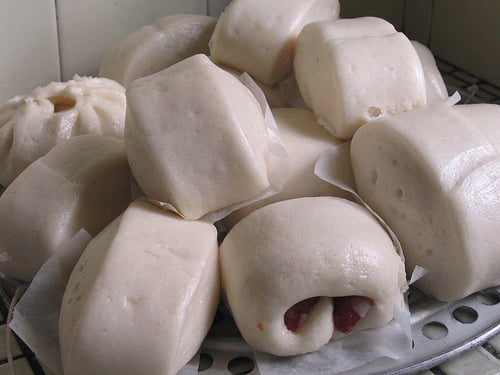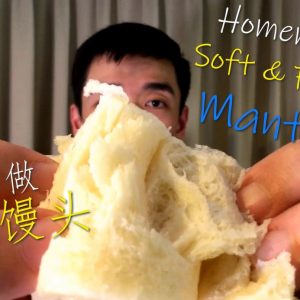Learn how to make soft, fluffy Mantou—classic Chinese steamed buns that are perfect for any meal.
Mantou is a staple in Northern Chinese cuisine, known for its light, airy texture and subtle sweetness. Whether you enjoy them plain, filled, or dipped in condensed milk, these buns are surprisingly easy to make at home with just a few ingredients.
In this step-by-step guide, you’ll discover how to create restaurant-quality Mantou using traditional techniques with modern shortcuts. Great for breakfast, snacks, or even savory pairings—this recipe ensures soft, pillowy results every time.
Mantou in other words is Chinese Steamed Bun, popular in Northern China (each region has its own cuisine type). For example, Shandong, Hebei, etc – their carbohydrates staple is mantou. Whereas some parts of China are hand-pulled noodles, but usually rice as the main carbohydrates diet staple.

Origin of Mantou
Mantou “馒头”, initial translation translated as “barbarian’s head” (蠻頭) which eventually evolved into the modern “馒头”. It was said that that the word “mantou” came from the era of the Three Kingdom when Zhuge Liang and his army met with a swift-flowing river that defied any attempt to cross it.
A barbarian warlord advises him that they would sacrifice men and threw their heads into the river to appease the river deity to allow them to cross. As Zhuge Liang does not want to sacrifice any of his men, he has all his livestock slaughtered that the army was brought along. Made buns shaped similar to human heads and filled with meats. These buns were then thrown into the river and eventually they cross the river successfully.
Making Mantou Recipe at home is much simpler than you could ever imagine!
A similar bun is a baozi. Mantou is the more common word, and in certain districts, (for example, the Jiangnan area of China, and Korea) mantou (or the equal neighborhood perusing of the word) can be utilized to demonstrate both the filled and unfilled buns, while in Japan they are known as “manjū” alludes just to filled buns.

More into Mantou ~
There are two methods of making Mantou
- Using aged dough
- Traditionally, an aged dough are used as an activator to rise the dough so the mantou would be fluffy, soft, and delicate, but they do take extra time to prove as well as extra effort in taking good care of the aged dough.
- Dry Yeast
- In the modern days, things got a lot easier as we now have a quick rise yeast and this way we save a lot of time! More importantly, there is no need to take care of an aged dough.
Author have a say…
Previously I posted a video of homemade mantou in China and some of you requested me to make one video of how to make mantou. Most commercially produce mantou in the supermarket are made with self raising flour and baking soda – they usually stick to your teeth when you take a bite. Hence the best thing about homemade mantou is they doesn’t stick to your teeth and the flavor is much more richer! You asked, here it is!
Chinese Steamed Bun Recipe - Healthy Homemade Mantou

Equipment
- Steamer
- Rolling Pin
Ingredients
- 2 cups All Purpose Flour (or medium protein flour)
- 1 cup Fresh Milk (optional water)
- 1 tsp Yeast (Quick Raise)
- 2 tbsp Sugar
- 1/3 tsp Salt
- 2 tbsp Oil
- Parchment Paper / Large Tart Paper Cup ( 4″ x 3″ with both side folded)
This is a free content
I have to run Ads
Instructions
- Lightly reheat milk to lukewarm and add yeast, sugar and salt.
- Mix well and set aside for 10 minutes or until the yeast has activated.
- In a mixing bowl, add all purpose flour, milk mixture and oil.
- If your have a mixer, simply use the dough function and mix it until they come together as a dough.
- Otherwise, begin mixing them with your hands or a fork.
- When the flour has absorbed all the liquid, begin kneading.
- Knead for about 10 – 15 minutes.
- If the dough is too wet, add more flour, or if it is too dry, add more milk.
- Cover the dough with a damp cloth or a cling film.
- Let the dough proof in a warm area for 45 minutes or until it double in size.
- Once proofing is done, flour your working surface with all purpose flour.
- Transfer dough onto the floured surface.
- Use a rolling pin or simply just your palms to gently flatten the dough into a square or a rectangular sheets of about 0.5 cm thick.
- Roll the sheets into a rolls and then roll it into an even longer rolls.
- Cut dough into a few pieces, the size of a mantou.
- About 2 inches width. Gently pull it to shape it into mantou shape.
- Transfer them individually onto parchment paper or tart paper cup.
- Proof them in an enclose warm area for 45 minutes.
- If you have an oven, simply proof them in the oven with the light bulb turn on and a bowl of hot water.
- Steam them for 20 minutes.
- Serve hot!
Video
Nutrition
*These Nutritional Values have not been evaluated by the Food and Drug Administration
Recipe Variations
Once you master the basic Mantou recipe, try these delicious twists:
1. Milk Mantou
Replace water with full cream milk to give your buns a richer flavor and softer texture. This is perfect for a slightly sweeter bun that pairs beautifully with tea.
2. Pumpkin Mantou
Add steamed and mashed pumpkin to the dough for a vibrant color and slight earthy sweetness. Use about 100g pumpkin for every 250g flour.
3. Sweet Fillings
Fill the center of each dough ball with red bean paste, lotus seed paste, or custard. Make sure the filling is well-sealed to prevent leakage during steaming.
4. Savory Mantou
Add a pinch of salt and stuff with cooked minced meat, spring onions, or sautéed mushrooms. Serve as a side or main dish with dipping sauce.
5. Pan-Fried Mantou (a.k.a. “Silver Thread Buns”)
Steam your Mantou as usual, then pan-fry the bottom in oil until golden brown for a crispy texture on the outside and soft interior.
Frequently Asked Questions About Making Mantou
Q: Why is my Mantou not fluffy?
A: The dough may not have proofed enough, or the yeast may be expired. Ensure the dough doubles in size before shaping, and steam only after a second proof.
Q: Can I freeze Mantou?
A: Yes! Once steamed and cooled, wrap each bun in cling film and store in the freezer. To reheat, steam for 5–8 minutes straight from frozen.
Q: How do I reheat Mantou without a steamer?
A: Place buns on a microwave-safe plate, cover with a damp paper towel, and microwave for 30–60 seconds. Alternatively, wrap in foil and bake at 160°C for 10 minutes.
Q: Can I use whole wheat flour instead of white flour?
A: Yes, but your buns may be denser. To keep a fluffy texture, mix 50% whole wheat with 50% all-purpose flour.
Q: What’s the best flour for soft Mantou?
A: Use low-protein (cake or Hong Kong) flour for the fluffiest result. All-purpose flour works well too, especially when combined with a bit of cornstarch.




0 Comments